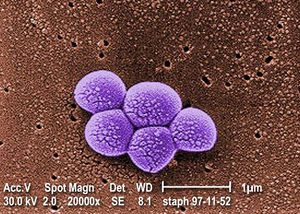The Effects of Sweeteners in the Gut Microbiome
Introduction

By Matthew Nguyen
Within the last decade, sweeteners have begun to play a crucial role in today’s society. Many people have started to look into new forms of sweeteners, both artificial and natural, to help meet caloric intake goals as well as for overall enjoyment of food and beverages being consumed. From stevia to aspartame, more and more sweeteners are being discovered and being approved by the Food and Drug Administration (FDA). Though consuming these lower calorie sugars may be beneficial for meeting calorie goals, it may not be beneficial for gut health in the long-run. Many factors contribute to why a person chooses to consume artificial sweeteners, including socioeconomic status and health goals. There have been many pros and cons found related to the consumption of artificial sweeteners. Throughout this review, we will discuss what effects sweeteners can have on the human gut microbiome and discuss if sweeteners really are beneficial to humans or if it's just hurting their bodies. Understanding the effects that sweeteners can have on the gut microbiome is beneficial for understanding what foods should and should not be consumed on a daily basis.
At right is a sample image insertion. It works for any image uploaded anywhere to MicrobeWiki.
The insertion code consists of:
Double brackets: [[
Filename: PHIL_1181_lores.jpg
Thumbnail status: |thumb|
Pixel size: |300px|
Placement on page: |right|
Legend/credit: Magnified 20,000X, this colorized scanning electron micrograph (SEM) depicts a grouping of methicillin resistant Staphylococcus aureus (MRSA) bacteria. Photo credit: CDC. Every image requires a link to the source.
Closed double brackets: ]]
Other examples:
Bold
Italic
Subscript: H2O
Superscript: Fe3+
Sample citations: [1]
[2]
A citation code consists of a hyperlinked reference within "ref" begin and end codes.
To repeat the citation for other statements, the reference needs to have a names: "<ref name=aa>"
The repeated citation works like this, with a forward slash.[1]
Human Gut Microbiome
To understand the effects that sweeteners can have on the human body, we must first understand the human gut microbiome. The human gut microbiome can be defined as the complex community of microorganisms that inhabit the gastrointestinal tract (Ruiz-Ojeda et al, 2019). This important organ that regulates metabolism, cellular immune response, and contributes to the host’s health is an extremely important element in the human body (Kasti et al, 2022). The bacteria and other microorganisms that make up the gut have an important role in maintaining immune and metabolic homeostasis as well as protecting against pathogens (Thursby et al, 2017). Though the gut is a very large and complex interface, the microbiota within provide many beneficial contributions. The microbiota strengthens the gut integrity, helps shape the intestinal epithelium, provides protection against pathogens, and regulates host immunity (Thursby et al, 2017). Researchers still do not fully understand the human gut microbiome as not all guts are the same. There are many people that eat a well-balanced diet, while there are others that consume high calorie food, like fast food restaurants. The amount of liquids a person consumes can also affect the gut microbiome, making it even more difficult for researchers to investigate.
There are many factors that contribute to the development of the gut including diet, environmental factors, and feeding methods throughout infancy. A persons’ diet contributes the most to the composition of the gut, due to many different types of bacteria being introduced to the already dense amount of bacteria. Diets that are high in resistant starch or non-starch polysaccharide fibre were shown to have much more bacterial diversity compared to diets that are more animal or plant based (Thursby et al, 2017). Another important factor that contributes to the development of the gut is feeding methods throughout a child’s infancy. Many babies are either fed via human milk (breast-feeding) or via formula. Studies have shown that there is an abundance of fucosylated oligosaccharides in breast milk that can be used by several bacteria species helping them to outcompete other more harmful bacteria (Thursby et al, 2017). When young infants are fed via formula, they lack these natural bacterias that breast milk contains, creating indifferences between babies fed via breast milk and babies fed via formula. When comparing these two feeding methods, there is no “right or wrong” method of feeding, as these bacterias found in breast milk are not essential for human growth.
Types of Sweeteners
There are two types of sweeteners that are used in food and beverage creation. Natural sweeteners are produced by nature, without any added chemicals (Neacsu et al, 2014). On the other hand, artificial sweeteners are substances that are used to replace natural sweeteners in foods and beverages with the goal to maintain a similar taste (Neacsu et al, 2014). Artificial sweeteners can be separated into two groups: nutritive sweeteners, which add some energy value to food and beverages, and non-nutritive sweeteners, which are used in very small amounts and add no energy value to food and beverages (Neacsu et al, 2014). Non-nutritive sweeteners are usually substituted in foods and beverages for a lower calorie intake. Many people counting calories will substitute foods and beverages containing non-nutritive sweeteners to be able to consume the foods that they enjoy, while still reaching their nutrition goals. Some examples of artificial sweeteners include acesulfame potassium, luo han guo, saccharin, and purified stevia leaf extracts ((Mayo Clinic Staff, 2023). These popular artificial sweeteners can be found in foods like baked goods, diet sodas, canned fruits, and flavored waters.
Section 3
Include some current research, with at least one figure showing data.
Section 4
Conclusion
References
Authored for BIOL 238 Microbiology, taught by Joan Slonczewski,at Kenyon College,2024
